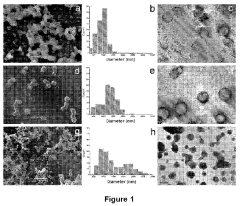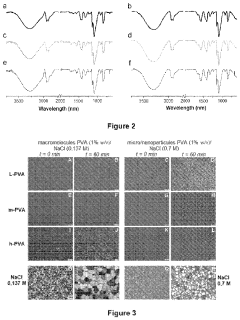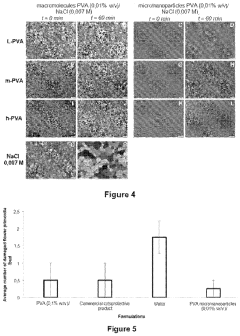How to Analyze Antifreeze Market Trends for Strategic Planning?
JUL 2, 20258 MIN READ
Generate Your Research Report Instantly with AI Agent
Patsnap Eureka helps you evaluate technical feasibility & market potential.
Antifreeze Market Overview and Objectives
The antifreeze market has experienced significant growth and evolution over the past decades, driven by the expanding automotive industry and increasing demand for temperature control solutions across various sectors. Antifreeze, also known as engine coolant, plays a crucial role in maintaining optimal operating temperatures for engines and industrial equipment, preventing freezing in cold climates and overheating in hot conditions.
The primary objective of analyzing antifreeze market trends for strategic planning is to gain comprehensive insights into market dynamics, consumer preferences, and technological advancements. This analysis aims to identify growth opportunities, potential challenges, and emerging trends that can inform decision-making processes and guide long-term business strategies in the antifreeze industry.
One of the key factors influencing the antifreeze market is the automotive sector's continuous growth and technological advancements. As vehicle production increases globally and engine designs become more sophisticated, the demand for high-performance antifreeze solutions continues to rise. Additionally, the growing focus on environmental sustainability has led to the development of eco-friendly antifreeze formulations, creating new market segments and opportunities for innovation.
The industrial sector also plays a significant role in shaping the antifreeze market landscape. Industries such as power generation, chemical processing, and HVAC systems rely heavily on antifreeze products for efficient operations. As these sectors expand and modernize, the demand for specialized antifreeze solutions tailored to specific industrial applications is expected to grow.
Geographically, the antifreeze market exhibits varying trends across different regions. Mature markets like North America and Europe focus on product innovation and environmental compliance, while emerging markets in Asia-Pacific and Latin America present growth opportunities due to rapid industrialization and increasing vehicle ownership rates.
To effectively analyze antifreeze market trends for strategic planning, it is essential to consider various factors such as raw material availability, pricing fluctuations, regulatory landscape, and technological innovations. By examining these elements, businesses can identify potential risks and opportunities, allowing them to develop robust strategies for market expansion, product development, and competitive positioning.
Furthermore, understanding consumer behavior and preferences is crucial for successful strategic planning in the antifreeze market. Factors such as brand loyalty, product performance, and price sensitivity play significant roles in shaping purchasing decisions. By analyzing these trends, companies can tailor their marketing strategies and product offerings to better meet customer needs and gain a competitive edge in the market.
The primary objective of analyzing antifreeze market trends for strategic planning is to gain comprehensive insights into market dynamics, consumer preferences, and technological advancements. This analysis aims to identify growth opportunities, potential challenges, and emerging trends that can inform decision-making processes and guide long-term business strategies in the antifreeze industry.
One of the key factors influencing the antifreeze market is the automotive sector's continuous growth and technological advancements. As vehicle production increases globally and engine designs become more sophisticated, the demand for high-performance antifreeze solutions continues to rise. Additionally, the growing focus on environmental sustainability has led to the development of eco-friendly antifreeze formulations, creating new market segments and opportunities for innovation.
The industrial sector also plays a significant role in shaping the antifreeze market landscape. Industries such as power generation, chemical processing, and HVAC systems rely heavily on antifreeze products for efficient operations. As these sectors expand and modernize, the demand for specialized antifreeze solutions tailored to specific industrial applications is expected to grow.
Geographically, the antifreeze market exhibits varying trends across different regions. Mature markets like North America and Europe focus on product innovation and environmental compliance, while emerging markets in Asia-Pacific and Latin America present growth opportunities due to rapid industrialization and increasing vehicle ownership rates.
To effectively analyze antifreeze market trends for strategic planning, it is essential to consider various factors such as raw material availability, pricing fluctuations, regulatory landscape, and technological innovations. By examining these elements, businesses can identify potential risks and opportunities, allowing them to develop robust strategies for market expansion, product development, and competitive positioning.
Furthermore, understanding consumer behavior and preferences is crucial for successful strategic planning in the antifreeze market. Factors such as brand loyalty, product performance, and price sensitivity play significant roles in shaping purchasing decisions. By analyzing these trends, companies can tailor their marketing strategies and product offerings to better meet customer needs and gain a competitive edge in the market.
Global Demand Analysis for Antifreeze Products
The global demand for antifreeze products has been steadily increasing, driven by the growth of automotive and industrial sectors worldwide. This trend is particularly evident in regions with extreme weather conditions, where antifreeze is essential for maintaining vehicle and machinery performance. The automotive industry remains the largest consumer of antifreeze products, accounting for a significant portion of the market share.
In recent years, there has been a notable shift towards more environmentally friendly antifreeze formulations. This change is primarily due to increasing environmental regulations and growing consumer awareness of ecological issues. As a result, propylene glycol-based antifreeze products have gained popularity over traditional ethylene glycol-based formulations, despite their higher cost.
The Asia-Pacific region has emerged as the fastest-growing market for antifreeze products, fueled by rapid industrialization and increasing vehicle ownership in countries like China and India. North America and Europe continue to be significant markets, with a focus on high-performance and long-life antifreeze products.
The commercial vehicle segment has shown robust growth in antifreeze demand, particularly in developing economies where infrastructure development and logistics sectors are expanding. This trend is expected to continue, contributing to the overall market growth.
Technological advancements in antifreeze formulations have led to the development of products with extended service life and improved heat transfer properties. These innovations are driving demand in both automotive and industrial applications, as they offer cost savings and enhanced performance.
The industrial sector, including power generation, chemical processing, and HVAC systems, represents a growing market for antifreeze products. The increasing adoption of renewable energy sources, such as solar thermal and geothermal systems, has created new opportunities for specialized antifreeze formulations.
Market analysts project a compound annual growth rate (CAGR) for the global antifreeze market in the mid-single digits over the next five years. This growth is attributed to expanding automotive production, increasing industrialization in emerging markets, and the ongoing development of more efficient and environmentally friendly antifreeze products.
In recent years, there has been a notable shift towards more environmentally friendly antifreeze formulations. This change is primarily due to increasing environmental regulations and growing consumer awareness of ecological issues. As a result, propylene glycol-based antifreeze products have gained popularity over traditional ethylene glycol-based formulations, despite their higher cost.
The Asia-Pacific region has emerged as the fastest-growing market for antifreeze products, fueled by rapid industrialization and increasing vehicle ownership in countries like China and India. North America and Europe continue to be significant markets, with a focus on high-performance and long-life antifreeze products.
The commercial vehicle segment has shown robust growth in antifreeze demand, particularly in developing economies where infrastructure development and logistics sectors are expanding. This trend is expected to continue, contributing to the overall market growth.
Technological advancements in antifreeze formulations have led to the development of products with extended service life and improved heat transfer properties. These innovations are driving demand in both automotive and industrial applications, as they offer cost savings and enhanced performance.
The industrial sector, including power generation, chemical processing, and HVAC systems, represents a growing market for antifreeze products. The increasing adoption of renewable energy sources, such as solar thermal and geothermal systems, has created new opportunities for specialized antifreeze formulations.
Market analysts project a compound annual growth rate (CAGR) for the global antifreeze market in the mid-single digits over the next five years. This growth is attributed to expanding automotive production, increasing industrialization in emerging markets, and the ongoing development of more efficient and environmentally friendly antifreeze products.
Antifreeze Industry Challenges and Opportunities
The antifreeze industry faces several challenges and opportunities that are shaping its landscape and influencing strategic planning. One of the primary challenges is the increasing environmental concerns surrounding traditional antifreeze formulations. As regulations become more stringent, manufacturers are under pressure to develop eco-friendly alternatives that maintain performance while reducing toxicity and environmental impact.
Another significant challenge is the volatility of raw material prices, particularly ethylene glycol, which is a key component in antifreeze production. Fluctuations in oil prices and supply chain disruptions can lead to unpredictable costs, affecting profit margins and pricing strategies for antifreeze manufacturers.
The automotive industry's shift towards electric vehicles (EVs) presents both a challenge and an opportunity. While traditional internal combustion engines require antifreeze for cooling, EVs have different thermal management needs. This shift necessitates the development of new antifreeze formulations specifically designed for EV battery cooling systems, opening up new market segments but also requiring significant R&D investment.
Climate change and extreme weather conditions are creating opportunities for the antifreeze industry. As temperatures become more unpredictable and severe weather events more frequent, there is an increased demand for high-performance antifreeze products that can withstand a wider range of temperatures and conditions.
The growing focus on energy efficiency in various industries, including HVAC systems and industrial processes, is driving the demand for advanced heat transfer fluids. This presents an opportunity for antifreeze manufacturers to expand their product lines and enter new markets beyond automotive applications.
Technological advancements in antifreeze formulations, such as the development of nanofluids and organic acid technology (OAT) coolants, offer opportunities for product differentiation and improved performance. Companies that can innovate and bring these advanced solutions to market will have a competitive edge.
Lastly, the expansion of the automotive and industrial sectors in emerging markets, particularly in Asia-Pacific and Latin America, presents significant growth opportunities for antifreeze manufacturers. However, this also brings challenges in terms of adapting products to local climate conditions and meeting regional regulatory requirements.
Another significant challenge is the volatility of raw material prices, particularly ethylene glycol, which is a key component in antifreeze production. Fluctuations in oil prices and supply chain disruptions can lead to unpredictable costs, affecting profit margins and pricing strategies for antifreeze manufacturers.
The automotive industry's shift towards electric vehicles (EVs) presents both a challenge and an opportunity. While traditional internal combustion engines require antifreeze for cooling, EVs have different thermal management needs. This shift necessitates the development of new antifreeze formulations specifically designed for EV battery cooling systems, opening up new market segments but also requiring significant R&D investment.
Climate change and extreme weather conditions are creating opportunities for the antifreeze industry. As temperatures become more unpredictable and severe weather events more frequent, there is an increased demand for high-performance antifreeze products that can withstand a wider range of temperatures and conditions.
The growing focus on energy efficiency in various industries, including HVAC systems and industrial processes, is driving the demand for advanced heat transfer fluids. This presents an opportunity for antifreeze manufacturers to expand their product lines and enter new markets beyond automotive applications.
Technological advancements in antifreeze formulations, such as the development of nanofluids and organic acid technology (OAT) coolants, offer opportunities for product differentiation and improved performance. Companies that can innovate and bring these advanced solutions to market will have a competitive edge.
Lastly, the expansion of the automotive and industrial sectors in emerging markets, particularly in Asia-Pacific and Latin America, presents significant growth opportunities for antifreeze manufacturers. However, this also brings challenges in terms of adapting products to local climate conditions and meeting regional regulatory requirements.
Current Antifreeze Formulations and Applications
01 Market analysis and forecasting
The antifreeze market trends are analyzed using advanced forecasting techniques and market intelligence tools. This includes studying consumer behavior, industry dynamics, and economic factors to predict future demand and growth opportunities in the antifreeze sector.- Market analysis and forecasting: The antifreeze market trends are analyzed using advanced forecasting techniques and market intelligence tools. This includes studying consumer behavior, industry dynamics, and economic factors to predict future demand and growth opportunities in the antifreeze sector.
- Environmental and regulatory impact: Environmental concerns and regulatory changes are significantly influencing the antifreeze market. There is a growing trend towards eco-friendly and biodegradable antifreeze products, driven by stricter environmental regulations and increased consumer awareness of sustainability issues.
- Technological advancements in antifreeze formulations: Ongoing research and development efforts are focused on improving antifreeze formulations. This includes developing more efficient heat transfer properties, extending product lifespan, and enhancing compatibility with modern engine materials and cooling systems.
- Market segmentation and regional trends: The antifreeze market is segmented based on product types, applications, and geographical regions. Different regions show varying trends in antifreeze consumption, influenced by factors such as climate, vehicle population, and industrial development.
- Supply chain and distribution strategies: Evolving supply chain management and distribution strategies are shaping the antifreeze market. This includes the adoption of e-commerce platforms, direct-to-consumer models, and strategic partnerships to optimize product availability and market penetration.
02 Technological advancements in antifreeze formulations
Ongoing research and development efforts are focused on improving antifreeze formulations. This includes developing eco-friendly alternatives, enhancing thermal efficiency, and creating multi-functional products that offer additional benefits such as corrosion protection or extended service life.Expand Specific Solutions03 Regulatory impact on antifreeze market
Changes in environmental regulations and safety standards are influencing the antifreeze market. Manufacturers are adapting their products to comply with stricter guidelines, which is driving innovation in more sustainable and less toxic antifreeze solutions.Expand Specific Solutions04 Supply chain and distribution trends
The antifreeze market is experiencing shifts in supply chain management and distribution strategies. This includes the adoption of digital platforms for inventory management, direct-to-consumer sales channels, and optimization of logistics to improve efficiency and reduce costs.Expand Specific Solutions05 Regional market dynamics and growth opportunities
Analysis of regional antifreeze market trends reveals varying growth rates and opportunities across different geographical areas. Factors such as climate conditions, automotive industry growth, and industrial development are influencing demand patterns and market expansion strategies in specific regions.Expand Specific Solutions
Key Players in Antifreeze Manufacturing
The antifreeze market is in a mature stage, characterized by steady growth and established players. The global market size is projected to reach several billion dollars by 2025, driven by increasing automotive production and industrial applications. Technologically, the industry is evolving towards more environmentally friendly and efficient formulations. Key players like BASF, Arteco NV, and Henkel AG & Co. KGaA are investing in R&D to develop advanced products, while companies such as Nippon Shokubai and Kaneka Corp. are focusing on innovative materials. The market is also seeing new entrants like Chongqing Jinlong Science & Technology, indicating ongoing opportunities for growth and innovation in this sector.
BASF Corp.
Technical Solution: BASF Corp. has developed advanced antifreeze formulations using their proprietary Glysantin® technology. Their products offer enhanced corrosion protection and extended coolant life, typically lasting up to 150,000 miles or 5 years[1]. BASF's antifreeze solutions incorporate organic acid technology (OAT) which provides superior heat transfer properties and reduces the formation of scale and deposits in cooling systems[2]. The company has also introduced bio-based antifreeze products, aligning with the growing demand for sustainable automotive solutions[3].
Strengths: Global market leader, extensive R&D capabilities, eco-friendly product options. Weaknesses: Higher price point compared to conventional antifreeze products, may require specific handling and disposal methods.
Tyco Fire Products LP
Technical Solution: Tyco Fire Products LP, while primarily known for fire protection systems, has developed antifreeze solutions for fire sprinkler systems. Their products are designed to prevent freezing in sprinkler pipes in cold environments, ensuring reliable fire protection[12]. Tyco's antifreeze formulations comply with NFPA standards and are UL listed for use in residential and commercial fire sprinkler systems[13]. The company's market analysis indicates a growing demand for antifreeze solutions in regions with harsh winter conditions, particularly in the construction and industrial sectors[14]. Tyco's strategic planning includes expanding their antifreeze product line to address specific industry needs and regulatory requirements[15].
Strengths: Established presence in fire protection industry, compliance with stringent safety standards, niche market focus. Weaknesses: Limited presence in automotive and general-purpose antifreeze markets, potential for market saturation in specialized applications.
Innovative Antifreeze Patents and Research
Antifreezing protein found in fish
PatentWO2004104201A1
Innovation
- The development of antifreeze proteins from Nagagaji and Sicirou fish species, involving the identification of their amino acid sequences, gene sequences, and production through gene expression and chemical synthesis, allowing for stable and cost-effective supply of AFPs.
Aqueous formulation that reduces damage caused by spring frosts in plants and production method thereof
PatentActiveUS20220312760A1
Innovation
- An aqueous formulation containing micro/nanoparticles of PVA, combined with stabilizing agents, emulsifiers, and pH buffers, which inhibits ice recrystallization and reduces frost damage in plants by up to 20% without harming harvested fruit, achieved through a precipitation or alkaline treatment process.
Environmental Regulations Impact on Antifreeze
Environmental regulations have become increasingly stringent in recent years, significantly impacting the antifreeze market. These regulations aim to reduce the environmental footprint of antifreeze products and promote more sustainable alternatives. The most notable impact has been on the composition of antifreeze formulations, with a shift towards more eco-friendly ingredients.
One of the primary regulatory focuses has been on the reduction of ethylene glycol, a common antifreeze component known for its toxicity. Many jurisdictions now require manufacturers to include bittering agents in ethylene glycol-based products to deter accidental ingestion by children and animals. This has led to increased production costs and the need for reformulation of existing products.
The push for more environmentally friendly alternatives has also driven innovation in the antifreeze market. Propylene glycol-based antifreeze, which is less toxic and more biodegradable, has gained popularity as a result of these regulations. This shift has created new opportunities for manufacturers who can develop and market these greener alternatives effectively.
Waste management regulations have also had a significant impact on the antifreeze industry. Many regions now require proper disposal and recycling of used antifreeze, leading to the development of specialized recycling facilities and services. This has created a new sub-sector within the antifreeze market focused on collection, treatment, and recycling of used products.
The implementation of more stringent emissions standards in the automotive industry has indirectly affected the antifreeze market. As vehicle manufacturers strive to meet these standards, they are developing more efficient cooling systems that may require specialized antifreeze formulations. This trend is driving research and development in the antifreeze sector to create products that can meet these evolving needs.
Global efforts to reduce greenhouse gas emissions have also influenced the antifreeze market. Some regions have implemented regulations on the use of certain chemicals with high global warming potential, which has implications for the production and use of some antifreeze components. This has spurred research into alternative compounds with lower environmental impact.
For strategic planning in the antifreeze market, companies must closely monitor and anticipate regulatory changes across different regions. Compliance with these regulations is crucial for market access and can provide a competitive advantage. Investing in research and development to create compliant and environmentally friendly products is becoming increasingly important for long-term success in this evolving market landscape.
One of the primary regulatory focuses has been on the reduction of ethylene glycol, a common antifreeze component known for its toxicity. Many jurisdictions now require manufacturers to include bittering agents in ethylene glycol-based products to deter accidental ingestion by children and animals. This has led to increased production costs and the need for reformulation of existing products.
The push for more environmentally friendly alternatives has also driven innovation in the antifreeze market. Propylene glycol-based antifreeze, which is less toxic and more biodegradable, has gained popularity as a result of these regulations. This shift has created new opportunities for manufacturers who can develop and market these greener alternatives effectively.
Waste management regulations have also had a significant impact on the antifreeze industry. Many regions now require proper disposal and recycling of used antifreeze, leading to the development of specialized recycling facilities and services. This has created a new sub-sector within the antifreeze market focused on collection, treatment, and recycling of used products.
The implementation of more stringent emissions standards in the automotive industry has indirectly affected the antifreeze market. As vehicle manufacturers strive to meet these standards, they are developing more efficient cooling systems that may require specialized antifreeze formulations. This trend is driving research and development in the antifreeze sector to create products that can meet these evolving needs.
Global efforts to reduce greenhouse gas emissions have also influenced the antifreeze market. Some regions have implemented regulations on the use of certain chemicals with high global warming potential, which has implications for the production and use of some antifreeze components. This has spurred research into alternative compounds with lower environmental impact.
For strategic planning in the antifreeze market, companies must closely monitor and anticipate regulatory changes across different regions. Compliance with these regulations is crucial for market access and can provide a competitive advantage. Investing in research and development to create compliant and environmentally friendly products is becoming increasingly important for long-term success in this evolving market landscape.
Antifreeze Supply Chain Analysis
The antifreeze supply chain plays a crucial role in the production, distribution, and consumption of antifreeze products. This complex network involves multiple stakeholders, including raw material suppliers, manufacturers, distributors, retailers, and end-users. Understanding the intricacies of this supply chain is essential for strategic planning and market trend analysis.
At the upstream level, the supply chain begins with the sourcing of key raw materials, primarily ethylene glycol and propylene glycol. These chemicals are typically produced by petrochemical companies and are subject to fluctuations in oil prices and global demand. The availability and pricing of these raw materials significantly impact the overall antifreeze market dynamics.
Manufacturers form the next link in the chain, transforming raw materials into finished antifreeze products. These companies often operate on a global scale, with production facilities strategically located to serve different regional markets. The manufacturing process involves blending the base chemicals with additives to create various antifreeze formulations tailored to specific applications and performance requirements.
Distribution networks play a vital role in connecting manufacturers with end-users. This segment includes wholesalers, distributors, and logistics providers who ensure the efficient movement of antifreeze products across different geographical regions. The effectiveness of these distribution channels can significantly influence market penetration and product availability.
Retailers represent the final link before reaching end-users. This includes automotive parts stores, service centers, and online platforms. The retail landscape has evolved with the rise of e-commerce, offering new opportunities and challenges for antifreeze suppliers to reach their target markets.
End-users of antifreeze products span various sectors, including automotive, industrial, and HVAC applications. Each sector has unique requirements and consumption patterns, which influence supply chain dynamics and market trends. For instance, the automotive sector's shift towards electric vehicles may impact the demand for traditional antifreeze products in the long term.
Supply chain visibility and integration have become increasingly important in recent years. Advanced technologies such as IoT sensors, blockchain, and AI-driven analytics are being employed to enhance supply chain efficiency, reduce costs, and improve forecasting accuracy. These innovations enable stakeholders to respond more effectively to market fluctuations and consumer demands.
Sustainability considerations are also shaping the antifreeze supply chain. There is a growing focus on developing eco-friendly antifreeze formulations and implementing more sustainable production and distribution practices. This trend is driven by both regulatory pressures and changing consumer preferences, necessitating adaptations throughout the supply chain.
At the upstream level, the supply chain begins with the sourcing of key raw materials, primarily ethylene glycol and propylene glycol. These chemicals are typically produced by petrochemical companies and are subject to fluctuations in oil prices and global demand. The availability and pricing of these raw materials significantly impact the overall antifreeze market dynamics.
Manufacturers form the next link in the chain, transforming raw materials into finished antifreeze products. These companies often operate on a global scale, with production facilities strategically located to serve different regional markets. The manufacturing process involves blending the base chemicals with additives to create various antifreeze formulations tailored to specific applications and performance requirements.
Distribution networks play a vital role in connecting manufacturers with end-users. This segment includes wholesalers, distributors, and logistics providers who ensure the efficient movement of antifreeze products across different geographical regions. The effectiveness of these distribution channels can significantly influence market penetration and product availability.
Retailers represent the final link before reaching end-users. This includes automotive parts stores, service centers, and online platforms. The retail landscape has evolved with the rise of e-commerce, offering new opportunities and challenges for antifreeze suppliers to reach their target markets.
End-users of antifreeze products span various sectors, including automotive, industrial, and HVAC applications. Each sector has unique requirements and consumption patterns, which influence supply chain dynamics and market trends. For instance, the automotive sector's shift towards electric vehicles may impact the demand for traditional antifreeze products in the long term.
Supply chain visibility and integration have become increasingly important in recent years. Advanced technologies such as IoT sensors, blockchain, and AI-driven analytics are being employed to enhance supply chain efficiency, reduce costs, and improve forecasting accuracy. These innovations enable stakeholders to respond more effectively to market fluctuations and consumer demands.
Sustainability considerations are also shaping the antifreeze supply chain. There is a growing focus on developing eco-friendly antifreeze formulations and implementing more sustainable production and distribution practices. This trend is driven by both regulatory pressures and changing consumer preferences, necessitating adaptations throughout the supply chain.
Unlock deeper insights with Patsnap Eureka Quick Research — get a full tech report to explore trends and direct your research. Try now!
Generate Your Research Report Instantly with AI Agent
Supercharge your innovation with Patsnap Eureka AI Agent Platform!







